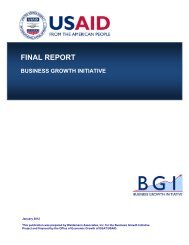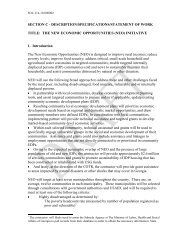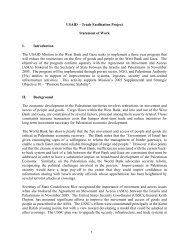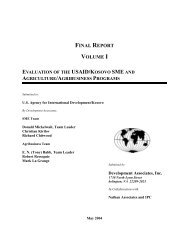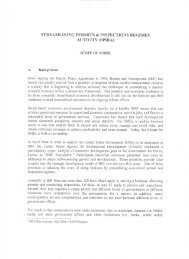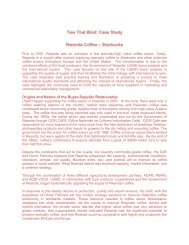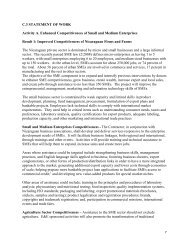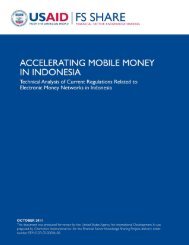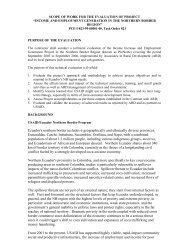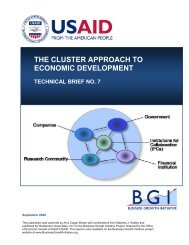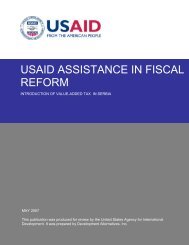Property Tax Reform in Developing and Transition Countries
Property Tax Reform in Developing and Transition Countries
Property Tax Reform in Developing and Transition Countries
Create successful ePaper yourself
Turn your PDF publications into a flip-book with our unique Google optimized e-Paper software.
<strong>and</strong> properties covered under a rent control act.<br />
In spite of these challenges, countries have pushed ahead with build<strong>in</strong>g a tax roll based on annual rental<br />
value. The actual assessment approach relies more on expert judgment than on hard empirical evidence.<br />
In practice, three approaches are taken to determ<strong>in</strong><strong>in</strong>g rental value. First, estimated market rental values<br />
might be imputed to all properties <strong>in</strong> a neighborhood. The “guidance” values that are used to make this<br />
imputation may be based either on available rent data from surveys, on expert judgment, or on a<br />
comb<strong>in</strong>ation of the two. This method is used for flats, some houses, <strong>and</strong> non-residential properties where<br />
there is some rental evidence available, <strong>and</strong> typically an adjustment is made for the area of the house.<br />
The best result that one can hope for under such a system is that variations <strong>in</strong> average rents paid <strong>in</strong><br />
different areas are roughly reflected <strong>in</strong> the assessment roll.<br />
The second approach to determ<strong>in</strong><strong>in</strong>g rental value is to estimate a capital value either from comparative<br />
sales data or by estimat<strong>in</strong>g the cost of acquir<strong>in</strong>g the l<strong>and</strong> <strong>and</strong> erect<strong>in</strong>g the build<strong>in</strong>g(s) on it. This method is<br />
most often used for factories, larger commercial establishments, <strong>and</strong> for owner-occupied hous<strong>in</strong>g where<br />
good rental value comparatives are not available. <strong>Countries</strong> use very different capitalization rates to<br />
convert these capital value amounts to a rental equivalent. For <strong>in</strong>stance, Malaysia’s capitalization rate is<br />
10 percent, while <strong>in</strong> Senegal it ranges from 3-8 percent.<br />
Third is a profits approach where an annual rate of return is estimated for the property. Net profits are<br />
determ<strong>in</strong>ed from the accounts of the firm, <strong>and</strong> the estimated amount of the l<strong>and</strong>lord’s share of these<br />
profits is then taken to be the annual rental value. While profitability may be objectively measured, the<br />
l<strong>and</strong>lord’s share is subjectively determ<strong>in</strong>ed.<br />
The result of this process—almost everywhere <strong>in</strong> the develop<strong>in</strong>g world—is dramatic underassessment.<br />
Even here we can only guess at the degree of underassessment because few low-<strong>in</strong>come countries carry<br />
out sales-assessment ratios to gauge the quality of their assessment. Mathur (1996) gives a flavor of the<br />
degree of underassessment <strong>in</strong> his review of Indian local government f<strong>in</strong>ance. He cites assessment ratios<br />
of 50 percent or lower <strong>in</strong> Calcutta, <strong>and</strong> 25 to 35 percent <strong>in</strong> Delhi <strong>and</strong> Madras. 4<br />
5.2 Capital Value Systems<br />
The capital value of l<strong>and</strong> <strong>and</strong> improvements is the pr<strong>in</strong>cipal form of property tax base used <strong>in</strong> OECD<br />
countries <strong>and</strong> <strong>in</strong> most Lat<strong>in</strong> American countries. The base <strong>in</strong> a capital value system is the market value of<br />
the property, i.e., the amount that the l<strong>and</strong> <strong>and</strong> improvements would sell for <strong>in</strong> an open market.<br />
Sometimes the legal, taxable base is the full market value of the property, <strong>and</strong> sometimes it is discounted<br />
by a fixed ratio of assessed to full value. 5<br />
Capital value systems get around some of the practical issues that plague rental value systems. S<strong>in</strong>ce the<br />
legal base is the true market value, conceptual problems with def<strong>in</strong><strong>in</strong>g the base <strong>in</strong> cases of vacant l<strong>and</strong>,<br />
rent controlled properties, <strong>and</strong> determ<strong>in</strong><strong>in</strong>g the taxable value for l<strong>and</strong> used for non-residential purposes<br />
are mostly elim<strong>in</strong>ated. While the sales of properties are reported, they usually are not accurately reported.<br />
4 The “assessment ratio” is the value of the property that is subject to tax expressed as a percent of the true market<br />
value of that property. For example, if a property has a true market rent of $10,000 but is assessed for purposes of<br />
property taxation at $4000, the assessment ratio would be 40 percent.<br />
5 In many Lat<strong>in</strong> American countries, vacant l<strong>and</strong> is taxed at a differentially higher rate, but <strong>in</strong> Peru, for example, it is<br />
not taxed at all (De Cesare, 2004).<br />
7



